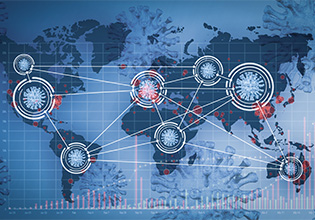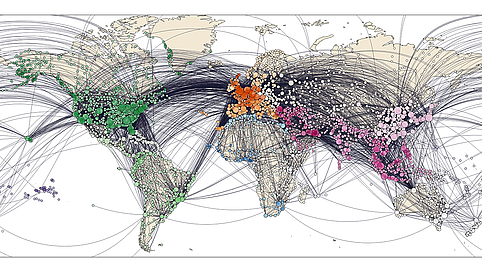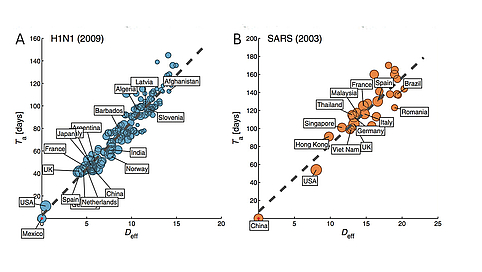Topic in Focus
Emergence of Pandemics

Image: Adobe Stock / macleg
A pandemic is a global challenge. The term is derived from the ancient Greek word pandemia, which means “belonging to all the people.” It thus refers to infectious diseases that affect the majority of the population. Pandemics often originate from pathogens transmitted from animals to humans. Our living conditions also contribute their part: worldwide trade, global mobility, or environmental damage favor the development and spread of infectious diseases. If a pandemic spreads, we have to react quickly.
What is an epidemic, what is a pandemic?
A pandemic refers to the spread of a disease over entire regions, countries, and continents. If the outbreaks of the disease remain spatially and temporally limited, scientists speak of an epidemic. A pandemic is, therefore, a global epidemic.
The causes of a pandemic are pathogens that previously have either never been present in the human population or have not been present for a very long time. The human immune system is not prepared for these pathogens and the human body is therefore not sufficiently protected from the disease. These are often strains of viruses or bacteria that were previously only found in animals, for example, bird flu viruses or swine flu viruses. The genetic material of the viruses can change; the viruses mutate. Because of this they also may be transferred to humans and cause serious diseases.
“Well, the fact that we can get infected with animal pathogens is not surprising. Biologically, humans are part of the animal kingdom, and for a pathogen, humans are just animals. There are indeed species boundaries, but there is no particular barrier between animals and humans. In other words, considering the differences between animals and humans and between animal species, the barriers are similarly high. So even in this context, humans are nothing special for a pathogen. Any direct or indirect contact can lead to transmission. In direct contact, we have aerosol transmissions, i.e., droplet infection; secretions and excretions also play a role. Then we have vectors, for example, insects, mosquitoes, ticks, and there is direct transmission through bites or injuries, which we know from rabies.”
The worldwide air transportation network: a global host mobility network. Each node represents an airport location, the links between the nodes are connections between these airports. Due to increased global mobility, the geographical distance to the initial point of an outbreak often no longer correlates with the theoretically expected time of arrival at another location in the world. Mathematical models and algorithms take into account global connectivity. Computer simulations can be used to make statistical predictions on the spatio-temporal pattern of modern, global disease dynamics. Source: Dirk Brockmann, Humboldt-Universität zu Berlin / Robert Koch-Institut
To model a disease outbreak, often the geographical distance to an initial outbreak location of a pandemic is used. The concept of effective distance takes into account the actual global connectivity. Here, a model of the H1N1 swine flu outbreak in 2009 (A) is compared to a model of the SARS outbreak in 2003 (B). Compared to the actual spread of H1N1 and SARS, models based on effective distance provided more accurate predictions of the rate of spread than models based on geographical distance. Effective distance thus allows better prediction of pandemic arrival times at further locations. Source: Dirk Brockmann, Humboldt-Universität zu Berlin / Robert Koch-Institut
The plague, for instance, is caused by a bacterium that occurs in rats and mice and is transmitted to humans via fleas. Examples of viruses are human influenza viruses, bird flu viruses, swine flu viruses, SARS coronavirus, MERS coronavirus, SARS-CoV-2 and the human immunodeficiency virus (HIV). According to the current state of knowledge, the SARS (Severe Acute Respiratory Syndrome) coronavirus was probably transmitted from bats to humans. The reservoir of the MERS (Middle East Respiratory Syndrome) coronavirus is considered to be dromedary camels (single-humped camels). These viruses were transmitted to humans either directly or through another animal species (intermediate host). The HI virus probably originates from primates. Some animal diseases, such as African swine fever, are not dangerous for humans. These pathogens cannot reproduce in humans.
“There are generalists, and there are specialists among pathogens. SARS-CoV-2, for example, is more of a generalist, which obviously can infect a whole range of different animal species, including humans. It is different from African swine fever, which is a specialist. That pathogen has adapted to the pig as its main host. So it has precisely two animals in which it can reproduce really well. One is the pig, and second, especially in Africa, the leather tick. This means that the pathogen has adapted in these two contexts, but not to other species, other animals.”
Animal pathogens and new combinations
Triggers for a pandemic can also be new virus combinations, so-called reassortants. In this case, genome fragments from at least two different virus strains mix to form a new virus. Such a virus emerges, for example, from the combination of human influenza viruses of different types or of a human influenza virus and an animal-derived virus. Pigs, in particular, can be carriers and vectors of such new combinations. They are considered a “mixing vessel”, as they can be infected with bird, human, and pig influenza viruses.
“This applies to influenza viruses. Influenza viruses have their natural reservoir in wild waterfowl. It means that influenza viruses are part of their ecology and biology. These virus populations need a certain docking point within the host so they can infect in the first place. Animal influenza viruses have different docking sites than human influenza viruses. The pig is characterized by the fact that it has docking sites for both groups of viruses. This means that it has docking sites for both avian viruses and human viruses. If it happens that both dock onto the same cell, these viruses can exchange genetic material. That leads to new combinations of genetic material and, thus, to the creation of, and I put this in quotation marks, actual 'new' viruses. And we can see this happening all the time. Not only in Asia or in distant countries, but also here in our regions.”
These pathogens can nevertheless only trigger a pandemic if they are not only transmitted from animal to human, but also from human to human. Since such viruses or bacteria are still unknown to the human immune system, the population lacks basic immunity against their infectious potential. This is what makes a pandemic without drugs and vaccines so unpredictable at first.
Our living conditions do matter
Scientists speak of zoonoses when pathogens are transmitted between animals and humans. The term is derived from the Greek words zoon = living being, and nosos = disease. Zoonoses can be caused by viruses, bacteria, fungi, parasites, or prions.
Classic examples of zoonoses are plague, rabies, tuberculosis, malaria, or salmonellosis. In the case of salmonellosis, the pathogen usually comes from laying hens and is transmitted via contaminated food. In humans, the pathogen then causes infectious diarrhea.
“If you read the zoonoses report, it is at least true for Germany that most zoonoses do not come from wild animals, but from farm animals. Most zoonotic infections here in Germany are food-borne infections with Salmonella or Campylobacter bacteria caused by eating contaminated food. New pathogens, in fact, very often come from wild animal reservoirs. This simply has to do with the fact that we know much less about our wild animals and the pathogens they carry than we do about farm animals and their pathogens. And again, every animal species has its own pathogen spectrum, i. e. its own specific pathogens.”
The conditions under which viruses cross the species barrier are still unclear. However, almost 70 percent of all infectious diseases are caused by pathogens originating from wildlife. The risk of new zoonoses has increased due to our modern living conditions. Factors such as the destruction of nature, mobility, worldwide exchange of goods or population growth favor the development and spread of zoonoses. Humans invade ecosystems, and in areas with adverse socio-economic conditions, humans and animals often live in very close proximity due to poverty. This increases the probability that pathogens spread to humans and infect them. Through global networking, international transport routes, and travel, the pathogens spread very quickly. To illustrate that human, animal, and environmental health are interdependent scientists refer to the “One Health” concept.
“The One Health context is a concept showing that human, animal, and environmental health are very closely related and inseparable. This means that we are moving away from the specialized approach of: there is human medicine, there is veterinary medicine and there is environmental medicine, towards a transdisciplinary approach that unites all three. And that is exactly what we are currently learning in many areas of infectious diseases. The environment plays a multifaceted role in ecology; in other words, how do contact areas between animals and humans develop? The environment plays a significant role here. But of course we also have factors in the environmental field, such as climate change, urbanization, population sizes and population growth, which have a strong and direct influence on the corresponding health care systems and health conditions.”



